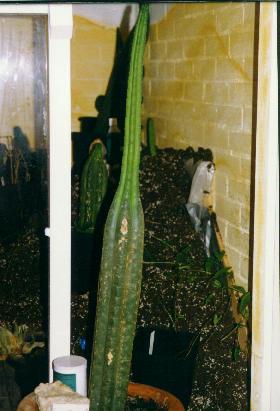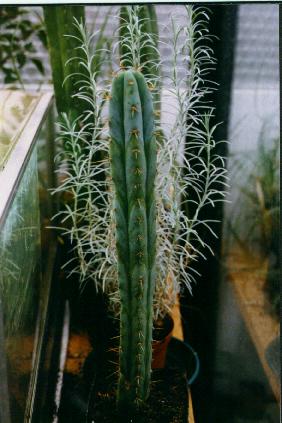| |
San Pedro
(Trichocereus
pachanoi) .
San
Pedro is a very easy to
cultivate
cacti. It can be grown from seeds and cuttings
. Growing them from seeds
goes in the same way as with Peyote.
Seeds
are here
available.
To grow
them
from cuttings is simple. Just cut the cacti in pieces of about 4cm
length
and leave these pieces for about one or two weeks, in this time
the
wound
will heal,
a callus is formed. The cuttings do stay alive for a very
long
time, so don't worry
about time and don't hurry, it is important
that the wound is really dry.
Once the
wound
is dry and something like a skin has formed, the cutting is ready.
Often
it is hard to see what is the top or bottom, in that case just plant it
on its side.
If it is clear, what is the top, then plant the cutting
straight
up, half in the earth.
You can use cacti earth from the local plant
shop,
but any good earth will do as well.
It might take some time before
growth
starts, somewhere between a few weeks up
to even a year.
San Pedro likes
it
hot, if you have a greenhouse, open the windows only in extreme
heat.
Indoors
it grows well, infact it is one of the fasted growing cacti. It can
grow
quite a bit in one season, sometimes half meter, under the right
conditions
(Peyote is
one of the slowest), which makes it for certain purposes a
lot
better.
When you live
in a
place where the days are quit short in winter, the cacti should be
kept
in a place with plenty light, at a temperature of
minimum 0-5C ( a
little above
freezing point) to 10C. It is important to keep them
during
winter
in a cool place, else they will start growing and start making thin
pieces
(see picture below). A thin waist might be nice for a woman, but for a
cactus it is ugly,
and makes it instable. The trick is to stop the
cactus
from growing during a period of
shortage of light. So it also important
not to give water in this period, this causes
growth and possibly even
rot. Don't worry, it is cacti and can stay without water for
long
periods.
In the
growing
seasons you can give them regularly water, fertilizer is appreciated,
both
natural and artificial. There is no real need of artificial
fertilizer,
if the plant is
regularly repotted or when natural fertilizer is used.
San
Pedro flower only after many years, rarely in cultivation, which is
pity,
because it has very beautiful flowers. There seems to be quite a lot of
variation in
the genus, like more or less needles, sometimes small
needles
and sometimes very
small.
|




